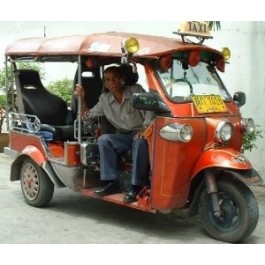The Tuk-Tuk first manufactured in Thailand in the 1960’s as an answer to the samlor that had been outlawed. The first rickshaw appeared in Bangkok in 1871 and many forms of human powered vehicles were devised that were to lead on to the development of the samlor (meaning three wheels). The samlor was often a 3-wheeled bicycle or a similar form of transport with 3-wheels that was human powered. A driver would sit astride a bicycle whilst the passengers sat at the rear under a canvas roof. As petrol powered vehicles became more popular the numerous samlors present on the roads began to cause increasing congestion and health hazards and so as a result the samlor became outlawed in the late 1950’s. The Tuk-Tuk is in effect a motorised samlor but with enough power to keep up with modern traffic.
The Tuk-Tuk is built by a number of companies that include Bajaj and Pholasith Motors Ltd though the structure is initially the same with many combinations of one vehicle that includes various forms of a taxi, van or open top truck. The vehicles are built from a steel frame whilst taxi versions have either a steel hard top or retractible canvas roof. Initally most taxis are designed to carry the driver and up to three passengers though larger versions can can up to seven people. As with the bodies the vehicles are also powered by a vast number of engines that range from 400cc 2-stroke engines up to larger Harley Davidson engines in Custom machines.
The Tuk-Tuk is used widely in Thailand and until recently in India. In 1990 Harley-powered taxis in New Delhi, India were banned which resulted in thousands of taxi drivers losing their jobs instantly. Numerous attempts have been made to ban the Tuk-Tuk in Bangkok but they have all been unsuccessful.



